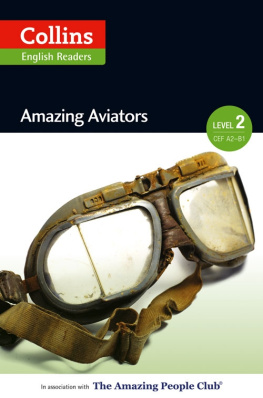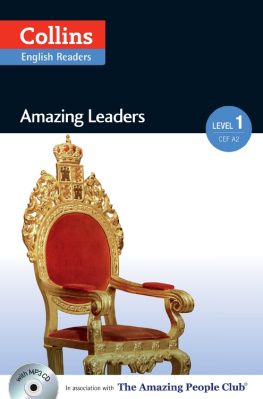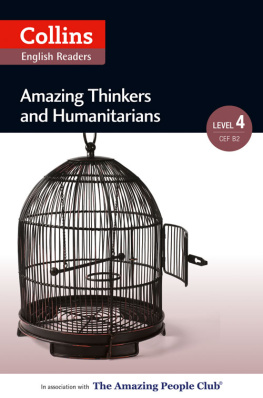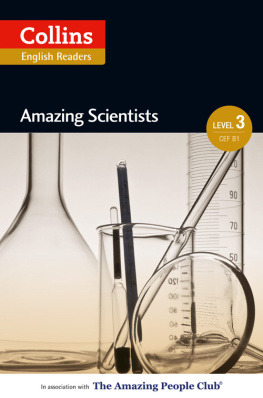You can choose to enjoy the book from start to finish or to dip in to your favourite story straight away. Each story is entirely independent.
After every story a short timeline brings together the most important events in each persons life into one short report. The timeline is a useful tool for revision purposes.
Words which are above the required reading level are underlined the first time they appear in each story. All underlined words are defined in the glossary at the back of the book. Levels 1 and 2 take their definitions from the Collins COBUILD Essential English Dictionary and levels 3 and 4 from the Collins COBUILD Advanced English Dictionary.
To support both teachers and learners, additional materials are available online at www.collinselt.com/readers.
The Collins COBUILD Grading Scheme has been created using the most up-to-date language usage information available today. Each level is guided by a brand new comprehensive grammar and vocabulary framework, ensuring that the series will perfectly match readers abilities.
For more information on the Collins COBUILD Grading Scheme, including a full list of the grammar structures found at each level, go to www.collinselt.com/readers/gradingscheme.
17401810
the man who helped humans to fly
All my life, I was an inventor . I designed the first hot-air balloons. My brother tienne and I made it possible for humans to fly through the air.
I was born on 26th August 1740, in Annonay, in the Ardche region of central France. My father, Pierre, owned a company which made paper in the town. My mother, Anne, gave Pierre 16 children, and I was the twelfth of them. When I was young, I was especially close to my brother, Jacques-tienne. tienne we all called him that was the fifteenth child. He was five years younger than me, but we were interested in the same things. In later years we worked together.
When we were children, tienne and I often watched birds flying. Perhaps people could learn to fly too, I sometimes thought. I had the mind of an inventor at an early age, and people called me a dreamer . I certainly dreamed about flying. tiennes mind was more practical than mine. While most of us stayed in Annonay, he moved to Paris. There, he studied to become an architect. However, he returned to us in 1772 when our eldest brother, Raymond, died. Raymond had been the manager of the familys paper-making business , after my fathers retirement . Now tienne took that job.
tienne was a very successful businessman , and as a result, our family became rich. But my interest in inventing things was strong. Many people thought that my ideas were strange, but I didnt listen to them. Fortunately, tienne didnt listen to them either.
In 1777, I had my first practical idea about human flight. One day, I was drying some cloth over a fire. I noticed that the cloth was moving. The hot air from the fire was lifting parts of it. I knew then that hot air was lighter than cold air, so I asked myself a question. Could hot air inside something that was heavier than air lift that thing off the ground? It was an idea that stayed in my mind.
In 1782, I was living in Avignon. I was interested in military planning at that time. I started to think about flying soldiers. Why was the idea of flying soldiers a good one? There were several reasons. For example, a soldier could fly over a battlefield. He could look down and see where his enemys soldiers were. That could help his own army. Or perhaps the soldiers themselves could attack their enemy from the air.
I remembered my idea about using hot air to make something fly, and I shared it with my brother. We agreed that the main difficulty was the fire. The air inside a flying machine had to be hot. It had to be lighter than the air around the machine. So we needed to make something which could fly, but which contained a fire. The fire had to burn safely. We didnt want it to burn the machine.
I started to make experiments . One day, I made a wooden frame with the shape of a box. It was about one metre by one metre by one metre in size. I covered the frame with cloth on five sides, but I didnt cover the bottom of the box. I placed the box on a metal stand and I made a fire under it.
My experiment was a success. The box the balloon, as I called it started to rise from the ground. Was this a kind of flying machine? Yes it was! I was indoors at that time, so the machine soon hit the ceiling, but I saw that my idea was practical. It was time to build a larger machine and take it outside.
I wrote to my brother. I asked him to get lots more cloth and some rope . He quickly did this, and he came to Avignon and joined me in my work. I told him that he was going to see something amazing.
On 4th December 1782, our first outdoor balloon was ready. It was a very basic balloon, about three times as large as the first one. No one could fly in that balloon. I wanted to demonstrate to people what could be done in the future. A large crowd came to see what was going to happen. Amazingly, the balloon ascended , and floated through the air for nearly two kilometres.
The next year, 1783, was the most important time for our work. We made a new balloon, which was larger than the second one. It had thick paper inside the cloth. This balloon held 790 cubic metres of air, and it weighed 225 kilograms. On 4th June that year, we gave a public demonstration of this balloon at Annonay. People from the government came to watch. Will the balloon leave the ground? everyone wondered. We were happy when the demonstration succeeded. The flight lasted ten minutes, and the balloon reached an altitude of about 2000 metres above the ground. Like the second balloon, it landed about two kilometres from where it left the ground.










